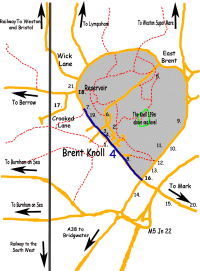 Brent
Knoll Walks - Walk 4: Through Brent Knoll Village Brent
Knoll Walks - Walk 4: Through Brent Knoll Village
This walk
of about two miles is through the main thoroughfare of the village.
Ordinary shoes are adequate. Please be careful of the traffic.
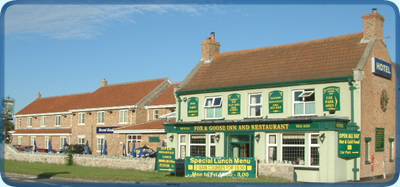 1.
Start from the Fox and Goose Public House where you will find
a Victorian Post Box in its side wall. This junction, known
as White Cross Corner, took its name from White Cross Farm on
the A38 almost opposite the Motor Home Showroom. The Fox and
Goose was a 19th century coaching inn. In 1883 the Brent and
Wedmore Harriers were housed there. Deer were also kept in the
grounds for hunting purposes. The hunt met twice a week. In
1889 the Inn boasted of good hotel accommodation for cyclists.
Recently modernised, it retains its historical character. Near
the site of the Mobile Home showroom stood "Greystones,"
once used as a tramps' doss house. Rabbit skins and rags were
sold. Later it became a well known and popular restaurant. 1.
Start from the Fox and Goose Public House where you will find
a Victorian Post Box in its side wall. This junction, known
as White Cross Corner, took its name from White Cross Farm on
the A38 almost opposite the Motor Home Showroom. The Fox and
Goose was a 19th century coaching inn. In 1883 the Brent and
Wedmore Harriers were housed there. Deer were also kept in the
grounds for hunting purposes. The hunt met twice a week. In
1889 the Inn boasted of good hotel accommodation for cyclists.
Recently modernised, it retains its historical character. Near
the site of the Mobile Home showroom stood "Greystones,"
once used as a tramps' doss house. Rabbit skins and rags were
sold. Later it became a well known and popular restaurant.
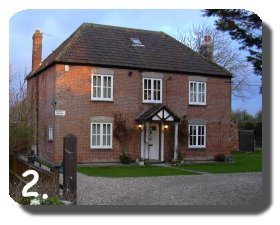 2.
Opposite the Fox and Goose, walk into Brent Knoll. A few yards
on the right is Croft House, a detached house with considerable
grounds. On the left is Athol Place where the onetime owner
was said to have been the first person in the west country to
go around hawking oil and candles. 2.
Opposite the Fox and Goose, walk into Brent Knoll. A few yards
on the right is Croft House, a detached house with considerable
grounds. On the left is Athol Place where the onetime owner
was said to have been the first person in the west country to
go around hawking oil and candles.
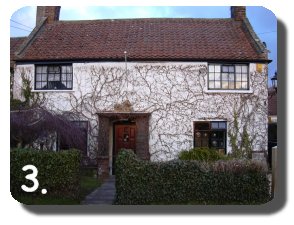 3.
The next house of interest is Lion Cottage on the right showing
a stone figure of a lion over its front door. Saddler's Cottage
follows shortly indicating the original rural nature of the
community. Several blacksmiths plied their trade in the village
until the middle of the 20th century. 3.
The next house of interest is Lion Cottage on the right showing
a stone figure of a lion over its front door. Saddler's Cottage
follows shortly indicating the original rural nature of the
community. Several blacksmiths plied their trade in the village
until the middle of the 20th century.
4. You will pass Warwick Court where once stood, within living
memory, The New Inn. Battleborough Lane leads behind the Post
Office so named after a battle in which the Saxons defeated
the Danes in AD 875 somewhere on the lower slopes of the Knoll.
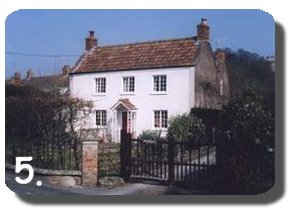 5.
The delightful Pen Orchard is set against the background of
the Knoll where orchards were once common on its lower slopes.
The village produced and still produces locally made cider.
The road narrows with Lavender Cottage and other period cottages
on your left. The road to the right leads up to an estate of
private homes set among woods and then goes on to St Michael's
Church. 5.
The delightful Pen Orchard is set against the background of
the Knoll where orchards were once common on its lower slopes.
The village produced and still produces locally made cider.
The road narrows with Lavender Cottage and other period cottages
on your left. The road to the right leads up to an estate of
private homes set among woods and then goes on to St Michael's
Church.
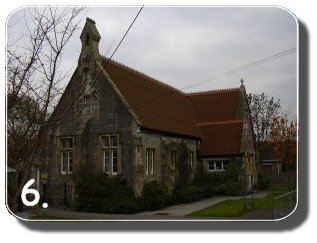 6.
The Village School on the left was opened in 1861, originally
as a Dame School run by two maiden ladies. Then it was an all
age school (5-14 years) until 1944 when it became a Primary
School. Move along and on the right you will see the impressive
Simon's Oak followed by the Methodist Chapel erected in 1837
by the Bible Christian Society. 6.
The Village School on the left was opened in 1861, originally
as a Dame School run by two maiden ladies. Then it was an all
age school (5-14 years) until 1944 when it became a Primary
School. Move along and on the right you will see the impressive
Simon's Oak followed by the Methodist Chapel erected in 1837
by the Bible Christian Society.
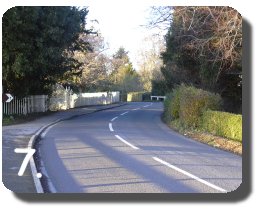 7.
The Chase, Kennett House and Nightingale Farm come next, all
of 18th century style. On the chicane stands Ivy Clad Hall,
built during the reign of Queen Anne, 300 years ago. It is easy
to imagine a carriage and pair bowling along the muddy or dusty
Brent Street to swing in through the white gates to stop outside
that impressive facade. 7.
The Chase, Kennett House and Nightingale Farm come next, all
of 18th century style. On the chicane stands Ivy Clad Hall,
built during the reign of Queen Anne, 300 years ago. It is easy
to imagine a carriage and pair bowling along the muddy or dusty
Brent Street to swing in through the white gates to stop outside
that impressive facade.
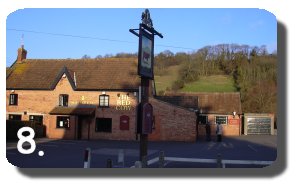 8.
On the right behind extensive grounds is The Croft which may
at one time have been used as a mill. A series of post war homes
lead you to the Red Cow Public House, a red bricked building
whose style of architecture suggests that parts of it were built
in the 18th century. Extensive views of the Knoll may be glimpsed
from its car park. Most of the older homes were built on the
Knoll side of Brent Street presumably to avoid flooding. 8.
On the right behind extensive grounds is The Croft which may
at one time have been used as a mill. A series of post war homes
lead you to the Red Cow Public House, a red bricked building
whose style of architecture suggests that parts of it were built
in the 18th century. Extensive views of the Knoll may be glimpsed
from its car park. Most of the older homes were built on the
Knoll side of Brent Street presumably to avoid flooding.
9. As you
retrace your steps towards the A 38 it is worth thinking that
one hundred years ago only horses, carts and pedestrians would
have used this thoroughfare, a quagmire in winter, a dust bowl
in a dry summer. Girls would have enjoyed bowling hoops along
the street, boys would have kicked stones. It is a very different
scene now.
|